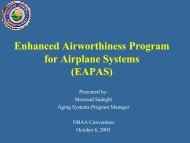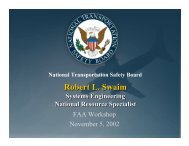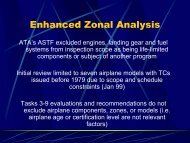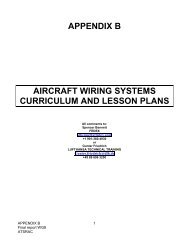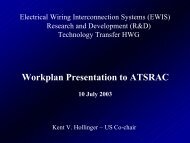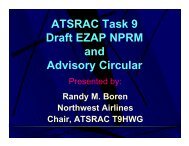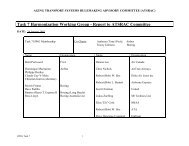Airport Capacity Benchmark Report 2001
Executive Summary - Center for Advanced Aviation System ...
Executive Summary - Center for Advanced Aviation System ...
- No tags were found...
You also want an ePaper? Increase the reach of your titles
YUMPU automatically turns print PDFs into web optimized ePapers that Google loves.
Executive SummarySetting the Framework for <strong>Benchmark</strong>sThe benchmarks in this report are a relatively simple expression of a complex quantity, airport capacity.They serve primarily as a reference point on the state of the airport system at a specific time. They canbe updated in the future to mark progress. They can also be used to identify and compare specific typesof airports, for instance to determine which airports are most severely affected by adverse weather or tocompare the prospects for airports that plan to build new runways to those that do not. The benchmarksalso provide a starting point for public policy discussions, because they give a succinct report on thecurrent and future state of major airport capacity.<strong>Benchmark</strong>s are useful data that help frame discussions. However, they are not a substitute for the moredetailed analysis that should precede major investment and policy decisions. In this sense they might becompared to a vital sign of human health, such as blood pressure. That simple indicator might be thestarting point for a diagnosis, but more information would be wanted before recommending surgery.Similarly, capacity benchmarks help identify problem areas but are not, in themselves, an adequate basisfor selecting remedies.This issue is apparent in the case of Atlanta Hartsfield International <strong>Airport</strong>. The scheduled operationsexceed the benchmarks several times daily in optimum weather and frequently under reduced rateconditions. The simple comparison of schedule to benchmarks suggests that some action is needed tocurtail the schedule. However, air traffic controllers, airlines, and the airport operator have indicated indiscussions that they are relatively comfortable with the current schedule and believe that it makesefficient use of the airport. Their judgment is based on vast experience and a broad understanding of airtransportation. Some of the considerations are specific to Atlanta (favorable runway configuration,weather patterns, and airspace structure), some are applicable to transfer hub airports in general (theconcentration of traffic into schedule peaks to allow passengers to make convenient transfer betweenflights, the ability to catch up with traffic between peaks in the schedule, and the ability of hubbing carriersto cancel and consolidate some flights during reduced rate conditions), and some are applicable to allbusy airports (the premise that some amount of congestion and delay is not inconsistent with efficient andaffordable air transportation).Purpose• The FAA has developed capacity benchmarks for 31 of the nation’s busiest airports to understand therelationship between airline demand and airport runway capacity and what we in the aviationcommunity can do about it.• <strong>Capacity</strong> benchmarks are defined as the maximum number of flights an airport can routinely handle inan hour.−These benchmarks are estimates of a complex quantity that varies widely with weatherconditions, runway configurations, and the mix of aircraft types. <strong>Capacity</strong> benchmarks assumethere are no constraints in the en route system or the airport terminal area. They are useful forbroad policy discussions and the development of long–term strategies.Methodology• Between October 2000 and April <strong>2001</strong>, the FAA and MITRE/CAASD developed capacity benchmarksfor 31 airports.• There are two rates for each airport – an optimum rate based on good weather conditions and areduced rate based on adverse weather conditions, which may include poor visibility, unfavorablewinds, or heavy precipitation.



